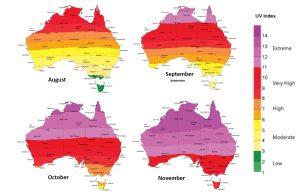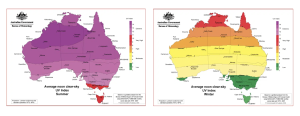A Backgrounds
As is known to all, people in Australia enjoy outdoor activities in their free time. Natural geographical and climate conditions make Australians embrace high UV levels. Unfortunately, skin cancer is one of the most diagnosed illnesses in Australian daily life. Years of public awareness campaigns by the Australian government have not led to a decrease in skin cancer rates. One significant reason is the attitude towards sun exposure, with young people, especially, tending to take big chances there. In this contemporary society, sun tanning as a latest beauty trend has become more and more popular. Additionally, this trend is especially favored by younger generations, who seem less serious about protecting themselves from sunlight.
Most young Australians do not fully understand how powerful the UV radiation in the country really is. Some people think that short-term sun exposure can’t hurt, while others say sunscreen is only necessary on hot days. Both of these thoughts are harmful, as a result, these young people are more likely to have skin cancer. Working on teaching young people more effectively with updated public messages may be essential to changing these mistaken ideas and improving future sun protection behaviors.
Story angle
I propose a feature article for ABC News, focusing on how younger generations in Australia are underestimating the dangers of UV exposure. The story will begin with the personal experience of a young university student who was diagnosed with skin cancer after years of tanning without protection.
Targeted readers
Young generations (students, influencers)—The core of this article is that young people overlook the importance of protecting themselves from sunlight.
Suggested interviewees
The article will explore the wider issue through interviews with dermatologists, educators, and young people (Caucasians and Asians), asking why public health messages are not helping this group effectively.
Multimedia, Hypertext and Interactivity
The article is well-designed with short paragraphs, which means that it is good for mobile reading. This article will also use embedded video from Youtube to enhance its multimedia interactivity. Moreover, hypertext will be used in this article to show some relevant reports or statistics. There is also a comments section where people can talk about their own sun safety habits and share personal experiences with skin health.
Supporting evidences or media elements
Firstly, Cancer Council Australia highlights that around two-thirds of Australians are diagnosed with skin cancer.
An article from Bureau of Meteorology shows that how powerful the UV radiation in Australia really is.
Additionally, a news article from Generation Sunsmart shows the graphs of average noon clear-sky UV index in summer and winter.

This article seeks to raise awareness and motivation by highlighting the attitudes of young people toward risks in UV exposure. With personal stories, expert insights, and strong visual elements, it will spark public discussion and support better health education on sun protection in Australia—particularly among young people who are often overlooked in traditional activities and be vulnerable to long-term skin damage.

Be the first to comment